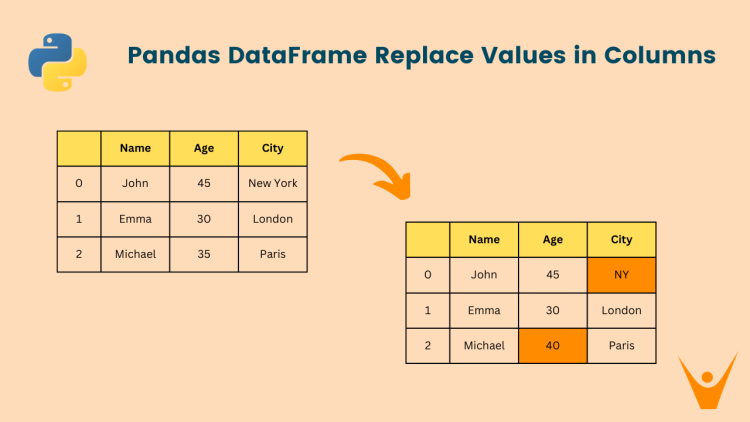Pandas provides a plethora of functions to manipulate and analyze data efficiently, making it a favorite among data scientists and analysts. In this article, we will discuss various methods we can use to replace column values in a DataFrame in Pandas Python.
4 Methods to Replace Column Values in DataFrame
One common task in data preprocessing is replacing values in specific columns. It can be useful for correcting errors, inconsistencies, or inaccuracies in the data. Additionally, the ability to replace values is instrumental in transforming data to meet specific analysis requirements, addressing outliers, and adhering to business rules or guidelines.
Here are 4 unique ways to replace column values in Pandas DataFrame:
1) Using the .replace() Method
The Pandas library provides the .replace() method in Python to replace columns in a DataFrame. The .replace() method is a versatile way to replace values in a Pandas DataFrame. It allows you to specify the column, the value to replace, and the replacement value.
Let us see how it works to replace column values in Pandas DataFrame with an example:
import pandas as pd
data = {'Name': ['Alice', 'Bob', 'Charlie', 'David'],
'Age': [25, 30, 35, 40],
'City': ['New York', 'Los Angeles', 'San Francisco', 'Chicago']}
df = pd.DataFrame(data)
# Display the original DataFrame
print('Original DataFrame:\n', df)
# Use the .replace() method
df_copy = df.copy()
df_copy['City'].replace('New York', 'NY', inplace=True)
# Display the updated DataFrame
print('Updated DataFrame:\n', df_copy)Output:
Original DataFrame:
Name Age City
0 Alice 25 New York
1 Bob 30 Los Angeles
2 Charlie 35 San Francisco
3 David 40 Chicago
Updated DataFrame:
Name Age City
0 Alice 25 NY
1 Bob 30 Los Angeles
2 Charlie 35 San Francisco
3 David 40 Chicago
2) Using the loc() indexer
We can use the loc() indexer method to replace values based on a condition. This allows us to select specific rows and columns of a DataFrame and modify their values.
Let’s check out an example:
import pandas as pd
data = {'Name': ['Alice', 'Bob', 'Charlie', 'David'],
'Age': [25, 30, 35, 40],
'City': ['New York', 'Los Angeles', 'San Francisco', 'Chicago']}
df = pd.DataFrame(data)
# Display the original DataFrame
print('Original DataFrame:\n', df)
# Use the .loc() indexer
df_copy = df.copy()
df_copy.loc[df['Age'] > 30, 'Age'] = 30
# Display the updated DataFrame
print('Updated DataFrame:\n', df_copy)Output:
Original DataFrame:
Name Age City
0 Alice 25 New York
1 Bob 30 Los Angeles
2 Charlie 35 San Francisco
3 David 40 Chicago
Updated DataFrame:
Name Age City
0 Alice 25 New York
1 Bob 30 Los Angeles
2 Charlie 30 San Francisco
3 David 30 Chicago
3) Using Custom Functions with .apply()
We can also use pandas-apply to build custom functions for the replacement of columns in a DataFrame. We can apply a function to each element of a column and replace the values accordingly.
The following example uses apply method to replace column values:
import pandas as pd
data = {'Name': ['Alice', 'Bob', 'Charlie', 'David'],
'Age': [25, 30, 35, 40],
'City': ['New York', 'Los Angeles', 'San Francisco', 'Chicago']}
df = pd.DataFrame(data)
# Display the original DataFrame
print('Original DataFrame:\n', df)
# Custom function to replace the columns
state_mapping = {'New York': 'NY', 'Los Angeles': 'CA', 'San Francisco': 'CA', 'Chicago': 'IL'}
def replace_city_with_state(city):
return state_mapping.get(city, city)
# Use the .apply method
df_copy = df.copy()
df_copy['City'] = df_copy['City'].apply(replace_city_with_state)
# Display the updated DataFrame
print('Updated DataFrame:\n', df_copy)Output:
Original DataFrame:
Name Age City
0 Alice 25 New York
1 Bob 30 Los Angeles
2 Charlie 35 San Francisco
3 David 40 Chicago
Updated DataFrame:
Name Age City
0 Alice 25 NY
1 Bob 30 CA
2 Charlie 35 CA
3 David 40 IL
4) Using the .str.replace()
If you need to replace values within string columns, you can use the .str.replace() method. This method allows you to replace substrings within each element of a string column. This method performs string substitution within each element of the column.
Let us see an example:
import pandas as pd
data = {'Name': ['Alice', 'Bob', 'Charlie', 'David'],
'Age': [25, 30, 35, 40],
'City': ['New York', 'Los Angeles', 'San Francisco', 'Chicago']}
df = pd.DataFrame(data)
# Display the original DataFrame
print('Original DataFrame:\n', df)
# Use the .str.replace method
df_copy = df.copy()
df_copy['Name'] = df_copy['Name'].str.replace('Alice', 'Alicia')
# Display the updated DataFrame
print('Updated DataFrame:\n', df_copy)Output:
Original DataFrame:
Name Age City
0 Alice 25 New York
1 Bob 30 Los Angeles
2 Charlie 35 San Francisco
3 David 40 Chicago
Updated DataFrame:
Name Age City
0 Alicia 25 New York
1 Bob 30 Los Angeles
2 Charlie 35 San Francisco
3 David 40 Chicago
It is always important to handle missing values before replacing columns in Python. You can refer to pandas-fillna to learn how to handle the missing values in a Pandas DataFrame.
Conclusion
In this article, we learned the various methods of replacing a column in a DataFrame of the Pandas library in Python. We explored the replace() method, using apply(), using loc() methods to replace a column in the DataFrame. Replacement of columns is a fairly common application in data analysis. Hence, it is important to master all these methods to perform our tasks more effectively and efficiently.








